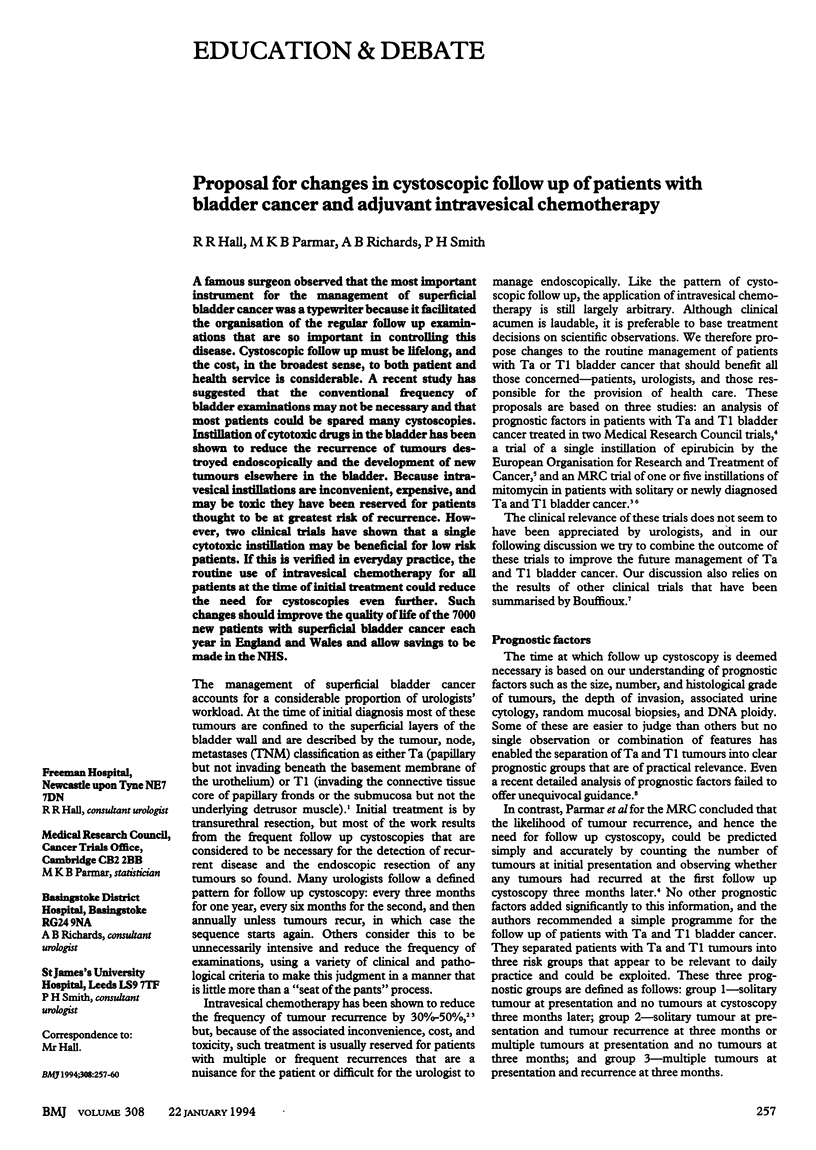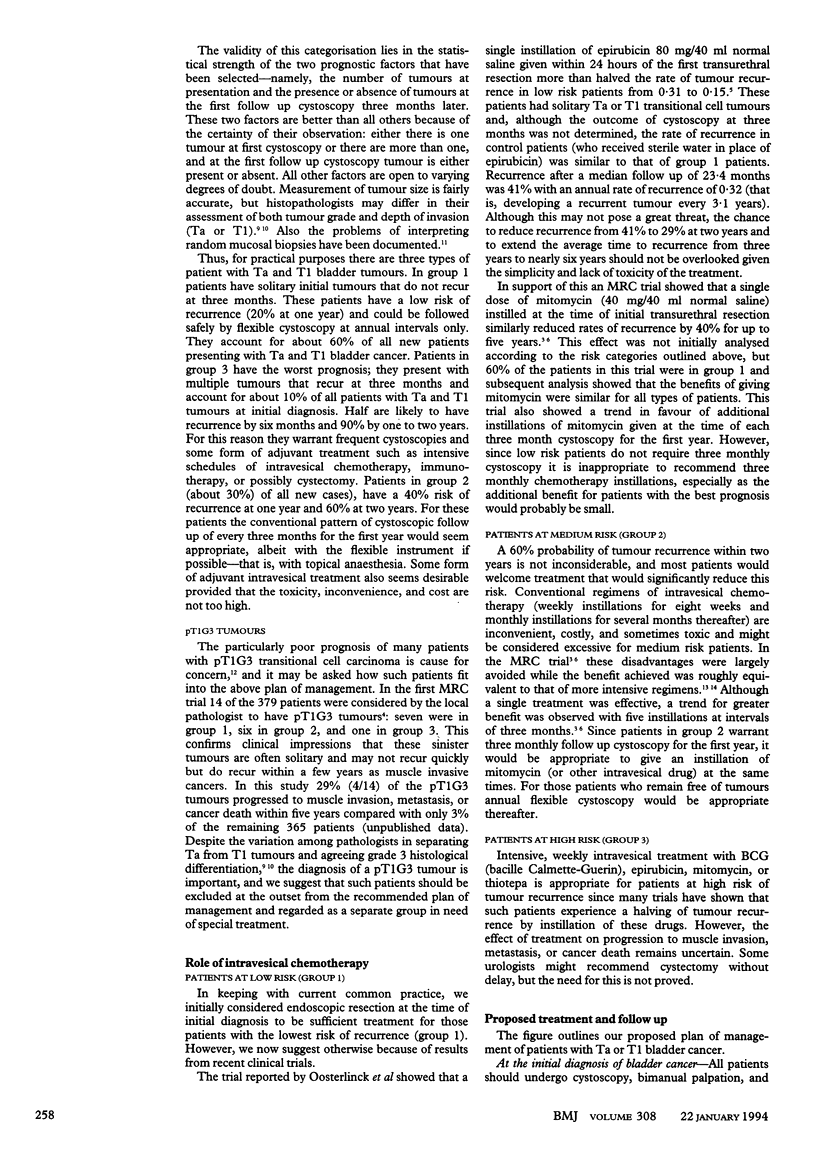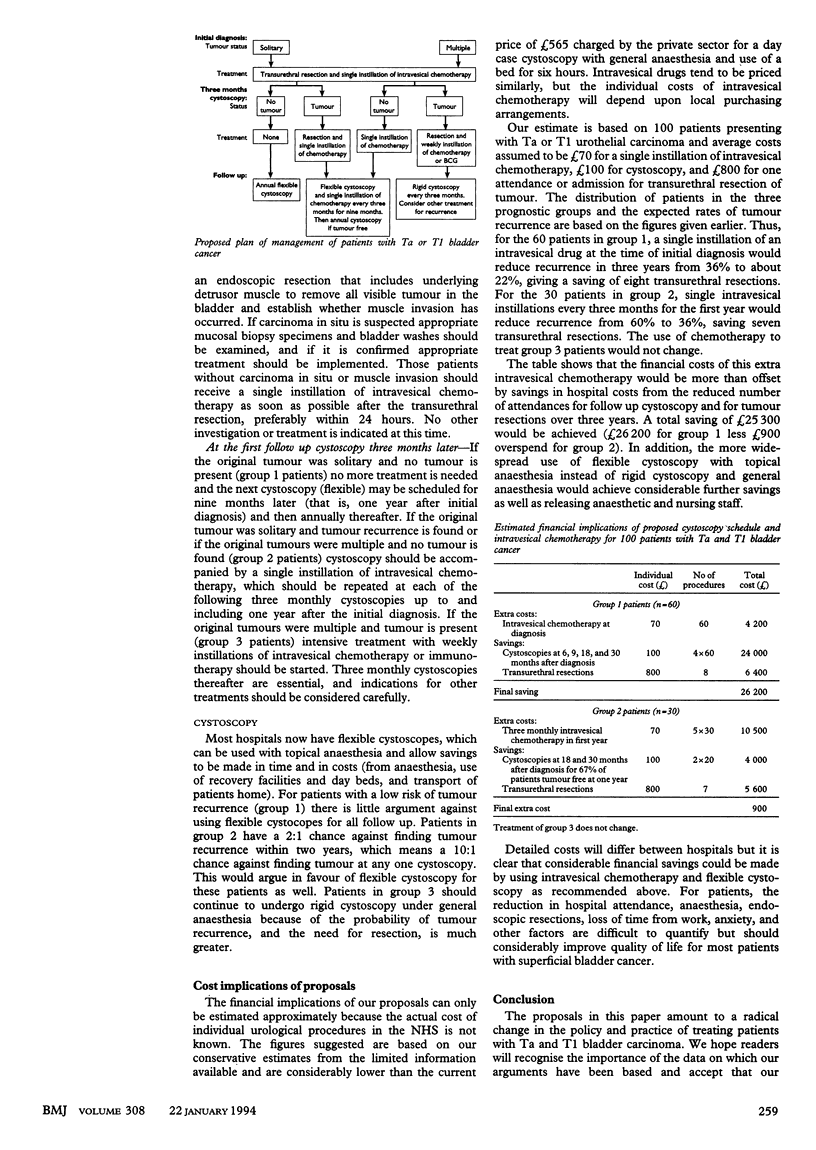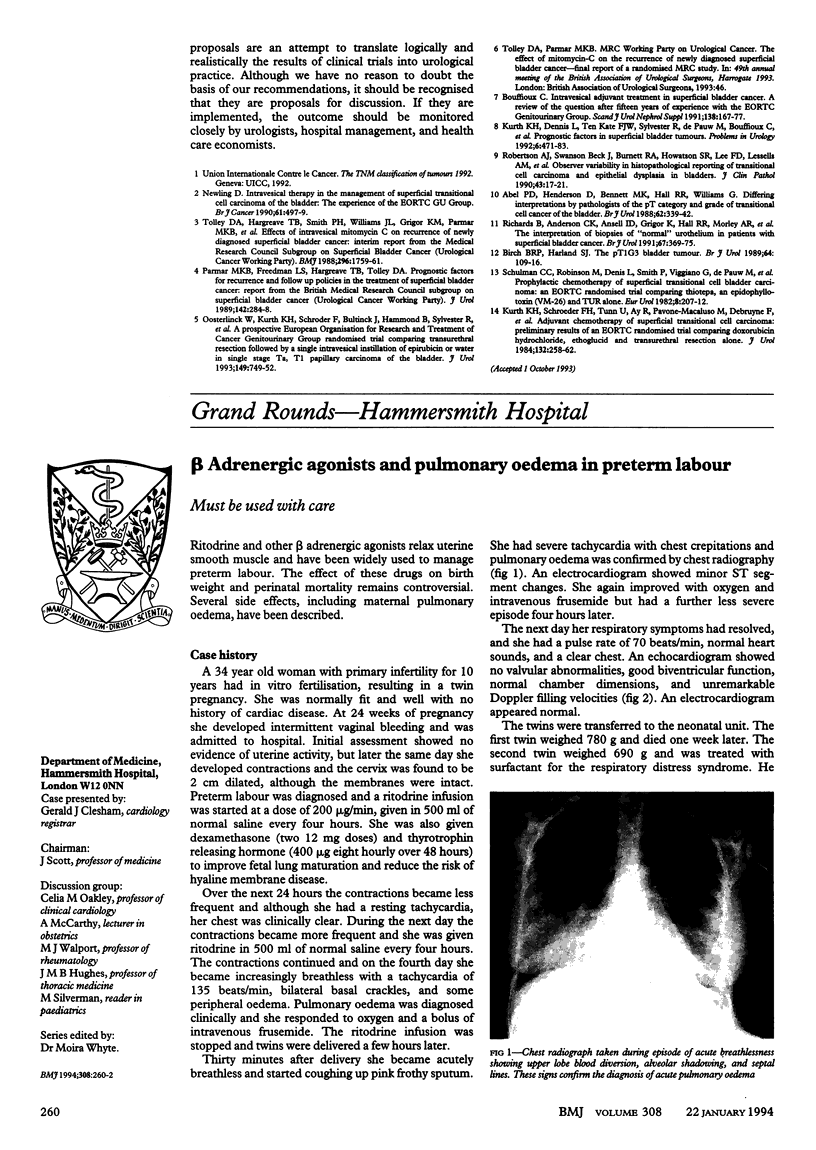Abstract
A famous surgeon observed that the most important instrument for the management of superficial bladder cancer was a typewriter because it facilitated the organisation of the regular follow up examinations that are so important in controlling this disease. Cystoscopic follow up must be lifelong, and the cost, in the broadest sense, to both patient and health service is considerable. A recent study has suggested that the conventional frequency of bladder examinations may not be necessary and that most patients could be spared many cystoscopies. Instillation of cytotoxic drugs in the bladder has been shown to reduce the recurrence of tumours destroyed endoscopically and the development of new tumours elsewhere in the bladder. Because intravesical instillations are inconvenient, expensive, and may be toxic they have been reserved for patients thought to be at greatest risk of recurrence. However, two clinical trials have shown that a single cytotoxic instillation may be beneficial for low risk patients. If this is verified in everyday practice, the routine use of intravesical chemotherapy for all patients at the time of initial treatment could reduce the need for cystoscopies even further. Such changes should improve the quality of life of the 7000 new patients with superficial bladder cancer each year in England and Wales and allow savings to be made in the NHS.
Full text
PDF



Images in this article
Selected References
These references are in PubMed. This may not be the complete list of references from this article.
- Abel P. D., Henderson D., Bennett M. K., Hall R. R., Williams G. Differing interpretations by pathologists of the pT category and grade of transitional cell cancer of the bladder. Br J Urol. 1988 Oct;62(4):339–342. doi: 10.1111/j.1464-410x.1988.tb04361.x. [DOI] [PubMed] [Google Scholar]
- Birch B. R., Harland S. J. The pT1 G3 bladder tumour. Br J Urol. 1989 Aug;64(2):109–116. doi: 10.1111/j.1464-410x.1989.tb05967.x. [DOI] [PubMed] [Google Scholar]
- Bouffioux C. Intravesical adjuvant treatment in superficial bladder cancer. A review of the question after 15 years of experience with the EORTC GU group. Scand J Urol Nephrol Suppl. 1991;138:167–177. [PubMed] [Google Scholar]
- Kurth K. H., Schröder F. H., Tunn U., Ay R., Pavone-Macaluso M., Debruyne F., de Pauw M., Dalesio O., ten Kate F. Adjuvant chemotherapy of superficial transitional cell bladder carcinoma: preliminary results of a European organization for research on treatment of cancer. Randomized trial comparing doxorubicin hydrochloride, ethoglucid and transurethral resection alone. J Urol. 1984 Aug;132(2):258–262. doi: 10.1016/s0022-5347(17)49582-6. [DOI] [PubMed] [Google Scholar]
- Newling D. Intravesical therapy in the management of superficial transitional cell carcinoma of the bladder: the experience of the EORTC GU Group. Br J Cancer. 1990 Apr;61(4):497–499. doi: 10.1038/bjc.1990.112. [DOI] [PMC free article] [PubMed] [Google Scholar]
- Oosterlinck W., Kurth K. H., Schröder F., Bultinck J., Hammond B., Sylvester R. A prospective European Organization for Research and Treatment of Cancer Genitourinary Group randomized trial comparing transurethral resection followed by a single intravesical instillation of epirubicin or water in single stage Ta, T1 papillary carcinoma of the bladder. J Urol. 1993 Apr;149(4):749–752. doi: 10.1016/s0022-5347(17)36198-0. [DOI] [PubMed] [Google Scholar]
- Parmar M. K., Freedman L. S., Hargreave T. B., Tolley D. A. Prognostic factors for recurrence and followup policies in the treatment of superficial bladder cancer: report from the British Medical Research Council Subgroup on Superficial Bladder Cancer (Urological Cancer Working Party). J Urol. 1989 Aug;142(2 Pt 1):284–288. doi: 10.1016/s0022-5347(17)38731-1. [DOI] [PubMed] [Google Scholar]
- Richards B., Parmar M. K., Anderson C. K., Ansell I. D., Grigor K., Hall R. R., Morley A. R., Mostofi F. K., Risdon R. A., Uscinska B. M. Interpretation of biopsies of "normal" urothelium in patients with superficial bladder cancer. MRC Superficial Bladder Cancer Sub Group. Br J Urol. 1991 Apr;67(4):369–375. doi: 10.1111/j.1464-410x.1991.tb15164.x. [DOI] [PubMed] [Google Scholar]
- Robertson A. J., Beck J. S., Burnett R. A., Howatson S. R., Lee F. D., Lessells A. M., McLaren K. M., Moss S. M., Simpson J. G., Smith G. D. Observer variability in histopathological reporting of transitional cell carcinoma and epithelial dysplasia in bladders. J Clin Pathol. 1990 Jan;43(1):17–21. doi: 10.1136/jcp.43.1.17. [DOI] [PMC free article] [PubMed] [Google Scholar]
- Schulman C. C., Robinson M., Denis L., Smith P., Viggiano G., de Pauw M., Dalesio O., Sylvester R. Prophylactic chemotherapy of superficial transitional cell bladder carcinoma: an EORTC randomized trial comparing thiotepa, an epipodophyllotoxin (VM26) and TUR alone. Eur Urol. 1982;8(4):207–212. doi: 10.1159/000473519. [DOI] [PubMed] [Google Scholar]
- Tolley D. A., Hargreave T. B., Smith P. H., Williams J. L., Grigor K. M., Parmar M. K., Freedman L. S., Uscinska B. M. Effect of intravesical mitomycin C on recurrence of newly diagnosed superficial bladder cancer: interim report from the Medical Research Council Subgroup on Superficial Bladder Cancer (Urological Cancer Working Party). Br Med J (Clin Res Ed) 1988 Jun 25;296(6639):1759–1761. doi: 10.1136/bmj.296.6639.1759. [DOI] [PMC free article] [PubMed] [Google Scholar]



